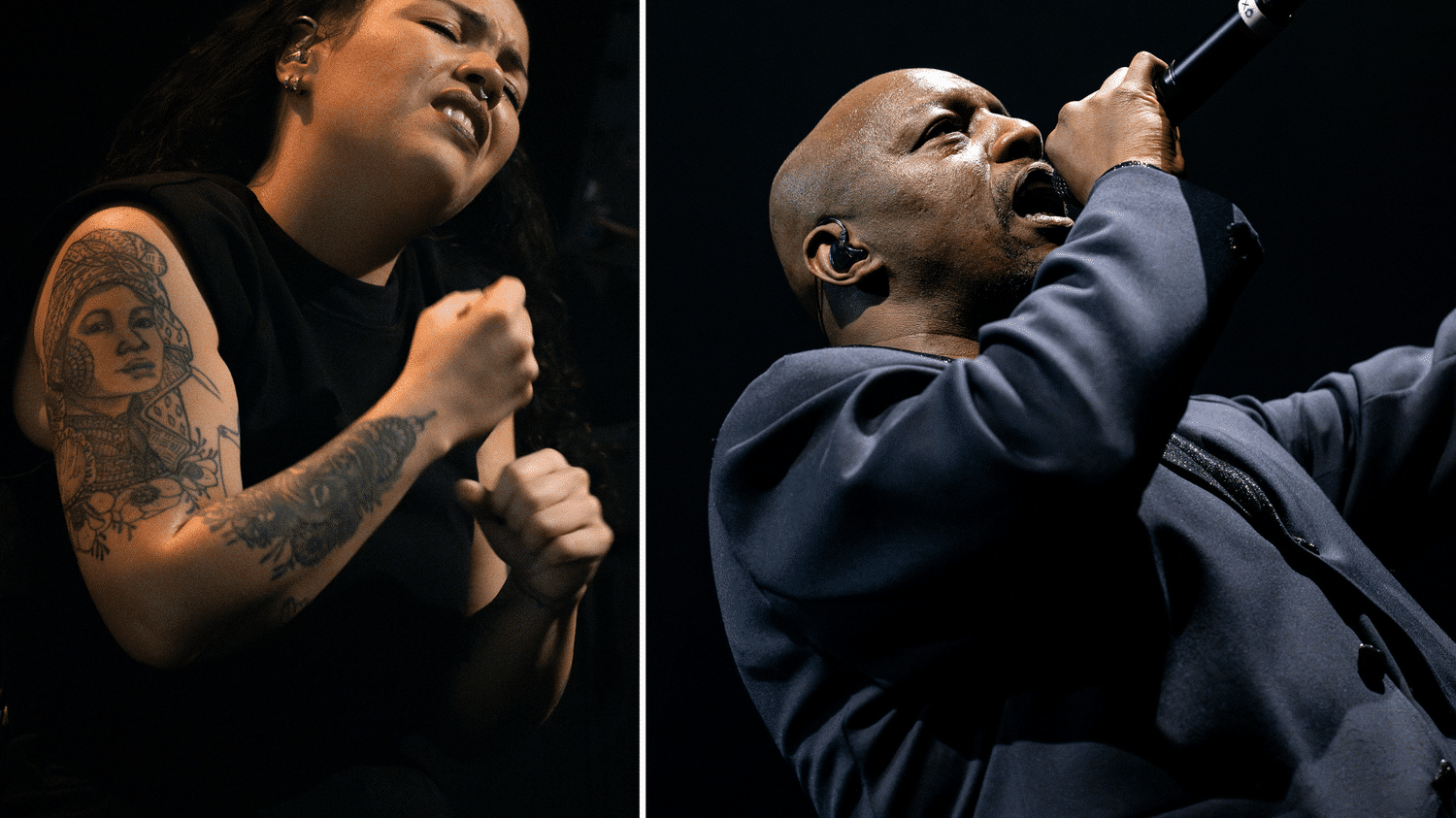The Collectif Integraal, which performs concerts in sign language, shared the stage of the Cité de la Musique on Sunday with rapper Oxmo Puccino. Proof of increasing accessibility, but the road remains long for deaf and hard of hearing audiences.
Published
Reading time: 4 min

There are the palms that collide, that make noise, and there are the hands that rise, the wrists that turn in silence. On the stage of the Pierre Boulez Hall of the Philharmonie de Paris, pianist Yaron Herman plays a few celesta notes while Oxmo Puccino appears discreetly. Dressed in a black suit with sequinned lapels, the rapper curtseys. The public welcomed him with thunderous applause, a small part of which was addressed to him in sign language.
Little present on stage in recent years, Oxmo Puccino brought together nearly 3,000 people on Sunday February 18 for a retrospective concert entirely designed by the Collectif Integraal. Chansigne is an artistic discipline which aims to interpret pieces of music in sign language. “The goal is to make events accessible in sign language and to encourage the signing public to welcome them,” explains Erremsi, rapper and co-founder of the collective.
“It’s a big emotion”
On the stage of the Philharmonie de Paris, three people take turns to sing the 20 pieces played by Oxmo Puccino and his musicians. In turn, they occupy the right end of the stage, the deaf and hard of hearing spectators having been placed in the room according to this position, and interpret the words rhythmically.

During purely instrumental moments, the singers sometimes resort to dancing to keep the music alive. “It’s not because there is no more text that the music stops,” explains Douboukan, one of the three performers of the evening, at the end of the concert. Still a little out of breath from her performance, she received a few thanks from the audience targeted by the song.
“It’s a big emotion,” explains Élie, a 22-year-old hearing-impaired spectator. “I had never been to a Chansigne concert before, it was an incredible surprise. I felt more included and I understood the rhythms better,” he adds. For her part, Nisrine has already attended several hip-hop concerts organized by the Collective Integraal. Aged 29, the young woman followed the music through interpretation and via a booklet of lyrics intended for the hearing-impaired audience. “I really like to follow the written words and the song at the same time in order to compare the metaphors”, she signs, “but what I like most is feeling included.”
1,500 working hours
The chansign allows you to offer a more complete experience. “Degrees of hearing vary. There are as many musical, auditory and sensory perceptions as there are individuals”, Erremsi analyzes. During live concerts, deaf or hard of hearing spectators can experience the music not only through the vibrations of the sound and the stage performance of the artists, but also through the understanding of the words and linguistic subtleties. As the rest of the public does while singing, the chansign allows the targeted audience to take up the refrains and live a collective experience.
This precious moment is the result of long preparation. “We consider that a show of around twenty titles requires around 1,500 hours of work”explains Erremsi. “We have been preparing the Oxmo Puccino concert for three months”, specifies Douboukan, “sometimes it takes us an hour to find the right translation.” This upstream work makes setting up a Chansigné concert relatively expensive, which explains in particular the fact that accessible shows are mainly offered by public institutions.
Accessibility still insufficient
If singing has developed considerably in recent years and especially since the Covid-19 crisis, the discipline remains relatively little known and rarely present at musical events. The Philharmonie de Paris offers between three and four changing concerts per season, a rare offering. “We try to offer a varied program ranging from opera to current music including concerts aimed at young audiences,” explains Helen Lamotte, head of the institution’s accessibility department.

If the lines seem to be moving, the Integraal Collective considers that “convincing cultural proposals for the deaf public remain very limited”. Performers deplore, among other things, the fact that certain artists consider the chansign as “a way to bring originality to their project” or only ask to translate a few pieces of a show, which does not allow for true inclusion.
“Believing that music is not for the deaf world is an erroneous prejudice, explains Erremsi. A tenth of the population is born or becomes deaf during their life, which is why this work is necessary. We hope that practices will improve and become more standardized so that anyone can go and enjoy a concert without even asking any questions.”
